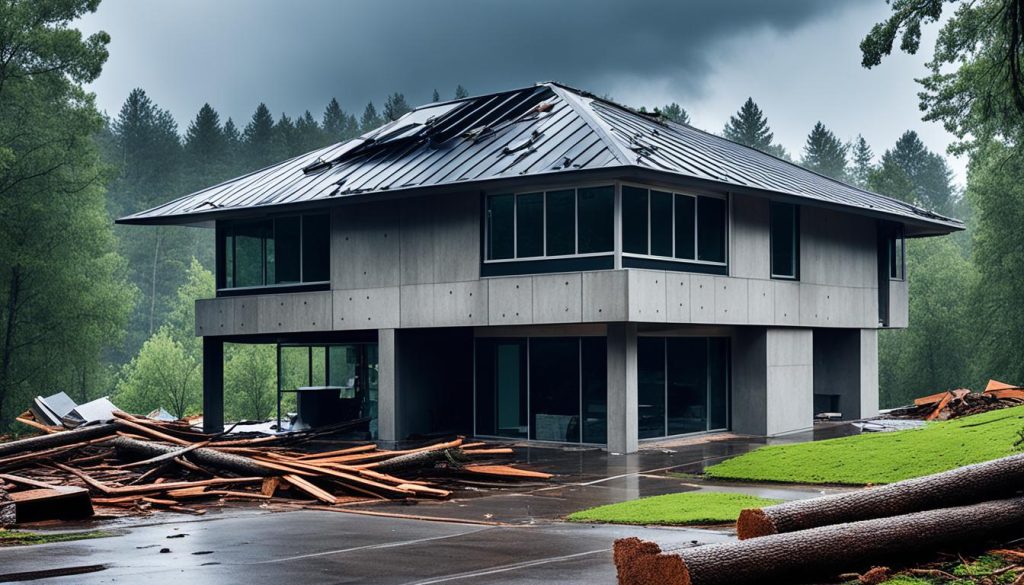Every year, natural disasters in the U.S. cause around $91 billion in damages. This is a big number to think about.
When you’re building your home, you must think about the dangers from earthquakes, hurricanes, floods, and fires. Picking materials that can stand up to these issues is smart. It not only keeps your home safe but also protects your family.
It’s key to focus on how strong and resistant your home’s materials are. This means your house can take on whatever nature throws at it. It will stay strong and safe for many years.
Key Takeaways
- Investing in disaster-resilient materials is essential for safeguarding your home and loved ones.
- Choose materials that are durable and can withstand earthquakes, hurricanes, floods, and fires.
- Prioritize resistance to natural forces over aesthetics when selecting building materials.
- Reinforced concrete, brick, and steel are recommended materials for disaster resilience.
- Consider installing impact-resistant windows and doors to protect against high winds and flying debris.
Choosing the Right Location for a Disaster-Resistant Home.
Deciding where to build a disaster-proof home is essential. It’s important to know the natural disaster risks in the area. This helps you prepare for specific dangers.
Avoid building in flood zones. These areas flood often, causing harm to homes. Coastal areas with storm surges are also risky. Being in these places can lead to property loss and risk during storms.
Choose your home’s spot carefully in earthquake areas. Frequent quakes can damage your home and harm its people. Watch out for wildfire-prone areas, too. These places, often dry, face more wildfire risk. Fires can burn down houses and threaten lives.
Don’t pick spots that are likely to flood or have landslides. Instead, go for elevated sites. These are safer from floods and serve as nature’s protection. Living on high ground means less worry about natural calamities affecting your home.
| Location Factors to Consider | Advantages |
|---|---|
| Flood zones | – Avoids the risk of flooding and water damage to your home – Ensures the longevity and structural integrity of your property |
| Coastal areas prone to storm surges | – Reduces the danger of property loss and hazardous conditions during storms – Minimizes the risk of structural damage to your home |
| Earthquake-prone regions | – Enhances the safety and well-being of occupants – Reduces the risk of structural damage due to earthquakes |
| High-risk wildfire zones | – Protects your home and loved ones from the devastation caused by wildfires – Minimizes the risk of property loss due to fire |
| Elevated sites | – Provides natural protection against flooding and landslides – Promotes a safer living environment for your family |
Selecting Disaster-Resilient Building Materials.
The choice of building materials is key when you’re making a home that stands up to disasters. While looks matter, picking materials that are tough and can fight off natural forces is crucial. Choosing the right materials boosts your home’s structure and makes it better at resisting damage from wind, water, and fire.
Reinforced concrete is a top pick for making your home tougher. This material is super strong and stands up well to earthquakes and other dangers. It lasts a long time because it has steel inside, which makes your home stronger.
Thinking about brick is a smart move, too. Bricks are known for being robust and lasting a long time against high winds and hits. They’re also good at not catching fire, making your home safer. Bricks keep your home cooler in summer and warmer in winter, which can save you money.
Steel is great for making your home extra strong. It’s durable and can take a lot of punishment, perfect for places prone to disasters. It offers great support and protects your home from strong winds and things that might hit it.
Don’t forget to put in impact-resistant windows and doors. They’re made to last through tough winds and things being thrown around in storms. Using them keeps your home strong and safe, even when the weather is severe.
Adding these disaster-resilient materials to your home makes it better at handling nature’s challenges. Focusing on making your home’s structure, wind, water, and fire protections strong brings peace of mind. It ensures your home is ready for any disasters it might face.
Designing and Reinforcing a Disaster-Resistant Home.
Creating a home that can withstand disasters starts with working with a skilled architect or engineer. They can design a house that’s strong and safe. They look at the area’s risks and use special methods to make your home tough against these threats.
The Role of Professional Architects and Engineers
It’s key to work with a pro architect or engineer to design such a home. They are experts in spotting and lowering risks for homes like yours. With their help, your house will be ready for natural disasters.
Reinforced Concrete Foundations
A strong, reinforced concrete base is crucial for a disaster-ready house. It protects your house from damaging earthquakes, hurricanes, and strong winds. This base is the first step in keeping your home safe during natural disasters.
Steel Frame Construction and Proper Bracing
Steel frames add extra strength to a disaster-resistant home. They’re very good at resisting earthquakes and strong winds, protecting your home and family. Using the right bracing methods further strengthens your house against disaster.
Waterproofing and Drainage Systems
Waterproofing and proper drainage fight against water damage. These include a waterproof layer, directing water away, and a sump pump. Keeping your home dry stops flood and rain damage.
Wind and Storm Protection Measures
Guarding your home from strong winds and storms is crucial. Things like hurricane straps and impact-proof windows and doors help a lot. They keep your roof secure and your house safe from flying items and fires.
Emergency Preparedness and Safety Equipment
Being ready for emergencies means having a plan and safety gear in place. Make sure you have escape plans and install alarms and fire preventers. A backup power source keeps you safe even when the power is out.
Homeowners’ Insurance and Regular Maintenance
Keeping your home safe includes having good insurance and doing checks often. Insurance that covers disasters is a must. Check your home every year to fix small issues before they become big problems.
Expertise in Custom Home Building
Getting advice from expert builders is wise. They know how to build homes that stand up to disasters. Their know-how is key in making a home that won’t easily be damaged.
With the right pros and plans in place, your home can be ready for anything. Along with the design elements, think about emergency plans, insurance, and upkeep. Following this advice helps make a home that’s strong and safe for your family.
Conclusion
Creating a disaster-resilient home is all about thinking ahead, planning, and using the right materials. Make smart choices to keep your home safe from natural disasters. This way, you not only protect your home but also invest in a secure future.
From 2000 to 2019, disasters hit the world hard, causing about $2.9 trillion in losses. They affected more than four billion people. Yet, by designing buildings to be resilient, we can lower the risks and costs of recovery.
Resilient building not just helps the environment during disasters. It also means buildings can change and meet people’s needs over time. Use materials like CLT, FRPs, bamboo, and other sustainable options for a safer structure.
The earthquake-ready Palazzo Italia Pavilion and the Mercedes-Benz Stadium are great examples. They both show how important it is to use resilient materials. Choosing these materials is a smart way to protect your home and family.

